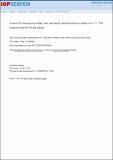A search for new physics in dijet mass and angular distributions in pp collisions at [subscript √s=7] TeV measured with the ATLAS detector
Author(s)
Taylor, Frank E.
DownloadAad-2011-A search for new physics in dijet.pdf (957.8Kb)
PUBLISHER_CC
Publisher with Creative Commons License
Creative Commons Attribution
Alternative title
A search for new physics in dijet mass and angular distributions in pp collisions at √s=7 TeV measured with the ATLAS detector
Terms of use
Metadata
Show full item recordAbstract
A search for new interactions and resonances produced in LHC proton–proton (pp) collisions at a centre-of-mass energy \sqrt{s}=7\,\textrm{TeV} was performed with the ATLAS detector. Using a dataset with an integrated luminosity of 36 pb− 1, dijet mass and angular distributions were measured up to dijet masses of ~3.5 TeV and were found to be in good agreement with Standard Model predictions. This analysis sets limits at 95% CL on various models for new physics: an excited quark is excluded for mass between 0.60 and 2.64 TeV, an axigluon hypothesis is excluded for axigluon masses between 0.60 and 2.10 TeV and quantum black holes are excluded in models with six extra space–time dimensions for quantum gravity scales between 0.75 and 3.67 TeV. Production cross section limits as a function of dijet mass are set using a simplified Gaussian signal model to facilitate comparisons with other hypotheses. Analysis of the dijet angular distribution using a novel technique simultaneously employing the dijet mass excludes quark contact interactions with a compositeness scale Λ below 9.5 TeV.
Date issued
2011-05Department
Massachusetts Institute of Technology. Department of PhysicsJournal
New Journal of Physics
Publisher
Institute of Physics Publishing
Citation
Aad, G et al. “A Search for New Physics in Dijet Mass and Angular Distributions in pp Collisions at \sqrt{s}=7 TeV Measured with the ATLAS Detector.” New Journal of Physics 13.5 (2011): 053044. Web. 16 May 2012.
Version: Final published version
ISSN
1367-2630